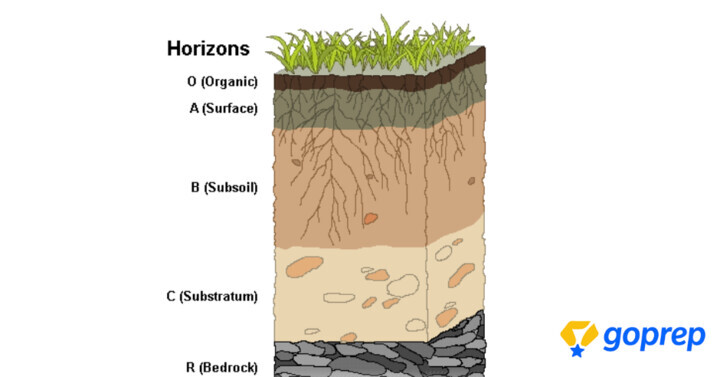Soil Profile: Different Layers of Soil Profile
In this article, you will study different layers of soil profile called soil horizons. Next, we will discuss what is soil profile, and its each horizon in detail. Soil Profile is another crucial topic discussed here.

Soil is a thin layer covering the earth’s surface, formed as a result of weathering of rocks. Beneath the soil, you will find several other layers, which are called soil horizons. The arrangement of these layers in the soil is referred to as soil profile.
You can differentiate one layer from another by observing soil properties such as colour, structure, texture, and thickness. Soil researchers use alphabets O, A, B, C, and E to mark different horizons in the soil profile. Let us dive deeper into the concept of the soil profile and its subtopics like soil horizon, soil moisture, etc.
What is Soil Profile?
If you dig a pit on land, you will observe different layers beneath the surface, which are called soil horizons (mentioned above). The arrangement of these layers or horizons is called a soil profile. Soil researchers often study the soil profile at the sides of a road on a hill or at a steep river bank.
Note: Most soil types have three major layers (horizon A, horizon B, and horizon C). In some soil types, you shall also find an organic horizon (O).
Soil Horizons | Different Layers of Soil Profile
Let us study the different types of soil horizons or layers in a soil profile here.
1. Horizon O
It is the top-most layer in some soil types. It is majorly composed of organic matter such as decomposing leaves, dried leaves, fallen trees, etc. This horizon appears thin in some soils, thick in others, depending on the time period of deposition.
2. Horizon A or Topsoil
A-horizon, also called topsoil, is the uppermost layer that is dark in colour and rich in humus and minerals. Presence of humus makes it a perfect fit for crops to grow. Further, it is soft, porous, and has good water holding capacity. Besides, it is home to various living organisms such as earthworms, beetles, moles, and rodents. Many small plants have their roots embedded in this layer.
3. Horizon B or Middle layer
The layer next to A-horizon in the vertical section of the soil is B-horizon. It has low humus content but more mineral concentration in comparison to topsoil. This layer can also hold a sufficient volume of water which is essential for the growth of crops.
4. Horizon C
The third layer is the C-horizon, which comprises small lumps of rocks with cracks and crevices. It is the parent material from which the other two layers of soil developed.
5. Bedrock
Bedrock is found towards the bottom of the soil profile. This layer is hard and difficult to dig with a spade. Its hard composition is due to the presence of granite, basalt, limestone or sandstone.
So far, we have studied the composition and characteristics of each layer. Next, we should learn about the water content of the soil profile.
Soil Moisture
Soil moisture is defined as the water content of the soil profile. The factors affecting the soil moisture are precipitation, temperature change, characteristics of soil, etc. In the case of less moisture, the growth of crops shall be disrupted which may lead to a decline in crop production.
‘Soil profile’ is an evergreen general awareness topic that can be asked in any competitive exam with a GA section. Students should also have a thorough understanding of this topic as it is a part of CBSE syllabus in Geography.
Frequently Asked Questions
- What is Soil Profile?
The soil profile is defined as the vertical section of the soil that comprises three major layers- A-horizon, B-horizon, and C-horizon.
- What is Soil Horizon?
Soil horizons are different layers of the soil profile that differs in colour, depth, and chemical composition.
- What determines the thickness of the soil profile?
Over a period of time, additional layers are deposited over the current layers of soil, leading to an increased thickness of soil profile. These additional layers are composed of sand, clay, humus, weathered rocks, etc.
- Why does the air above the land shimmers when you pass through farmland during hot summer days?
Due to hot weather, the rate of evaporation increases and water vapours are released by the soil. These vapours reflect the sunlight and the air above the soil creates a shimmer effect.
Tags

Mohit Chauhan
